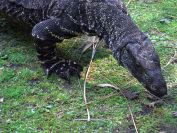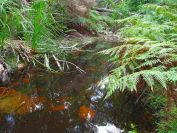Bittangabee Bay in Ben Boyd National Park on the Far south Coast of New South Wales (NSW) is a great place to camp and only 96km, an hour and a half drive, from our home in Bega to the north.
There's a pleasant, little beach of white sand at the head of Bittangabee Bay, a sheltered spot quite suitable for children. The area is rich in both Aboriginal and European history and there's a marked, coastal walk of 30km from Boyd's Tower to Greencape Lighthouse.
For me, the stand out feature of Bittangabee Bay is the red cliffs of square cut rock, dropping straight into deep water.
We had a few too many fore-quarter lamb chops that needed cooking, so after roasting them in the camp oven, sat down to a meal of hot meat.
Three big goannas, around two metres in length, came round the campsite. We're quite used to camping with goannas so were comfortable as they moved around us, walking under our chairs and generally sniffing around with their long, forked tongues.
One of the large monitors was sniffing around Lesley's feet, then suddenly stood tall and lunged at the chop in her hand, grabbing onto her finger. The brute refused to let go and was swinging it's head from side to side, apparently in preparation to crunch off the finger or swallow the whole hand.
The whole incident developed in a second or so. I sprang to my feet with the agility of a fit, 20 year old and sunk a size 8 1/2 steel cap boot into the attacker's guts with a thud that momentarily moved the left side of the goanna's body to where the right side had been, with desired affect. The scavenger scurried off toward the bush.
Rushing for the first aid box I applied peroxide and then bandaged the wound to stem the profuse bleeding. The bite had severed a vein and inflicted two gashes, half the length of Lesley's index finger, though I couldn't see the extent of the injury at the time for the blood pouring out.
When the goanna attack occurred, the weather was calm and sunny. I made the camp reasonably secure to leave for the hospital but as I rolled down the canvas canopy sides on the ute, a short, sharp, violent wind and rain squall hit.
Handing a neighbouring camper a bag of pegs and a tomahawk, I asked her to arrange to secure the tent. It's great how, among the camping fraternity, you can make such a request of a total stranger and it's OK.
The wind squall brought down several trees, most which we dodged around on the narrow track but drove straight over one small one. On reaching the Princes Highway, the road crew was already on the job removing several big trees that had closed the route north.
An xray was taken because teeth are often broken off and embedded in such a wound. The bleeding was finally stopped with a couple of stitches closing off the torn vein. A tetanus injection, antibiotics, splint to enhance healing and the hand heavily bandaged, I took Lesley home and stayed the night, returning alone to Bittangabee in the morning for the camping gear.
At a nearby camp I heard the story from the previous day of one of these goannas refusing to be shooed away, so the lady threw a gum boot at it. This should have done the trick, but instead the goanna turned toward her and stood tall in aggressive defiance.
Clearly these goannas have become used to scrounging a feed from campsites and have lost their fear of man to a greater extent than goannas at other such camping spots along the coast. Of course, this is the result of people feeding the wild animals or leaving food scraps where they can be eaten by native fauna which will, in response, frequent the camps and become a danger to humans.
I've sent an email to the NPWS suggesting the three goannas in question should be relocated well away from people, but whether they take any notice of my report is another matter.
What do you think about the feeding of native animals and the relocation of problem animals? Please leave your comments in the box below.










